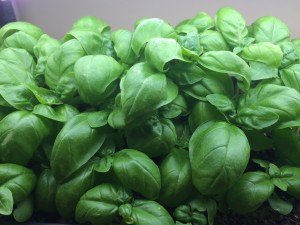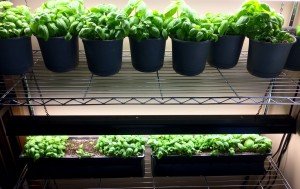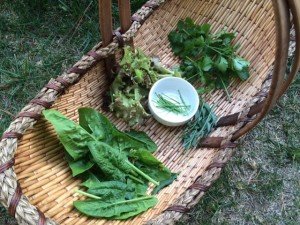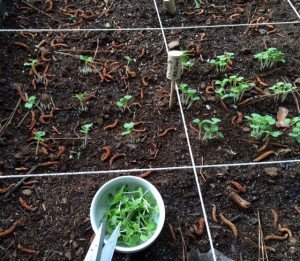Although I have grown herbs indoors for each of the last 5 winters, my indoor garden has always been in a designated growing area and not particularly convenient to the kitchen. So in a kitchen that is already small on space, I gave over fully 1/2 of my breakfast bar to try the AeroGarden, because the idea of growing fresh, green herbs right where I cook this winter is very appealing. That probably also explains the microgreens taking up the other 1/2 of my breakfast bar now.Microgreens are a great choice for indoor veggies in the off seasons since they aren't usually around long enough for pests or disease to become a problem and can be used in a variety of dishes. They do need a little more attention in terms of keeping them moist and harvesting on time, but that is all the easier when they are located in the heart of a home.My breakfast bar has become a living pantry :)
Read MoreWinter Growing
 This winter there will be a lot of focus on my indoor gardens mostly because my outdoor winter garden is a bit of a bust this year. The collards and spinach I planted were just beginning to grow when an unseasonable cold-snap halted them in their tracks. I tried resowing but still don't have much of anything green going on outside. I haven't given up completely on the 3 inch tall collards that I still hope will be served on New Years, but accept that I may be buying most of my good luck meal this year instead of growing it.Right now my indoor garden consists of two trays of basil microgreens (already harvesting from the tray on the left) and 8 pots of basil that will be allowed to grow into full plants of about 8" tall and pruned a bit daily as needed for meals.
This winter there will be a lot of focus on my indoor gardens mostly because my outdoor winter garden is a bit of a bust this year. The collards and spinach I planted were just beginning to grow when an unseasonable cold-snap halted them in their tracks. I tried resowing but still don't have much of anything green going on outside. I haven't given up completely on the 3 inch tall collards that I still hope will be served on New Years, but accept that I may be buying most of my good luck meal this year instead of growing it.Right now my indoor garden consists of two trays of basil microgreens (already harvesting from the tray on the left) and 8 pots of basil that will be allowed to grow into full plants of about 8" tall and pruned a bit daily as needed for meals. I will be starting another 3 trays of cilantro microgreens this weekend and will do various other types of microgreens (arugula, mustard and red cabbage) off and on all winter to add some homegrown flavor and crunch to winter meals.If you are considering indoor growing, microgreens have a lot going for them. They have a very quick turn around, usually only 2-4 weeks from beginning to end which is basically instant gratification in the gardening world. And due to their fast germination to harvest cycle, they aren't usually around long enough for pests and diseases to become an issue.These little plants really do have some powerful flavor, often even more than their adult versions and growing research from reputable sources is showing that some of them are packed with up to 5x the vitamins and carotenoids found in the adult versions of the same plants.So whether or not my outdoor garden takes off with this wonderfully sunny and warm week we are having, I will be posting (and eating) fresh all winter long.
I will be starting another 3 trays of cilantro microgreens this weekend and will do various other types of microgreens (arugula, mustard and red cabbage) off and on all winter to add some homegrown flavor and crunch to winter meals.If you are considering indoor growing, microgreens have a lot going for them. They have a very quick turn around, usually only 2-4 weeks from beginning to end which is basically instant gratification in the gardening world. And due to their fast germination to harvest cycle, they aren't usually around long enough for pests and diseases to become an issue.These little plants really do have some powerful flavor, often even more than their adult versions and growing research from reputable sources is showing that some of them are packed with up to 5x the vitamins and carotenoids found in the adult versions of the same plants.So whether or not my outdoor garden takes off with this wonderfully sunny and warm week we are having, I will be posting (and eating) fresh all winter long.
A Tisket, A Tasket
A tisket, a tasket, sandwich greens in my basket!Tonight's dinner shopping spree in the garden was for accouterments for egg salad sandwiches. Clockwise starting at the bottom is some spinach that is on the verge of bolting in this warm weather, some lola rosa lettuce, cilantro and those olive green sprigs at the 3 o'clock position are sweet pea shoots (trimmed from the growing tips of my producing plants) which add a light, sweet pea taste to any sandwich, salad or stir-fry. In the center are leek thinnings which I use like scallions and add a lightly onion taste to dishes. If you to garden but don't want to dine on salads nightly, I agree wholeheartedly and suggest we make a nice sandwich instead!
If you to garden but don't want to dine on salads nightly, I agree wholeheartedly and suggest we make a nice sandwich instead!
One Man's Trash is Another Man's Haute Cuisine
In the past couple of years microgreens have become a buzzword on restaurant menus and news articles talking about their nutritional content compared to the mature varieties of the same plant. Some early studies show that there may be reason to laud their nutritional content and chef's put them on their menus because they are delicious to the eye and the taste buds.I grow a number of indoor microgreens (basil, cilantro, mustard, arugula, beets) to add color, flavor and crunch to dishes but you don't have to set up a grow area to get some microgreens in your diet, you can just repurpose your plant thinnings.This year I overseeded my regular and dwarf varieties of pak choy and basil in my backyard garden because I was using 3 year old seeds and suspected that I would have low germination rates. Surprise, the seeds germinated at a remarkable rate and now I have a whole lot of extra seedlings that will have to be removed to make room for the vigorous individuals to grow to maturity. Rather than cut them and toss them in the compost, I let edible seedlings grow enough to be used as microgreens before snipping them down.Below you can see that I thinned one square of the dwarf pak choy that will be used as microgreens today and I will save thinning the square next to it until I can use them in a meal. Waste not, want not! Whether you are just thinning seedlings or clipping microgreens to go into your next meal, be sure to use scissors or a similar sharp pruner to cut the plants at soil level. If you pull on your thinnings, you may damage the delicate roots of the one you have selected to grow to maturity.
Whether you are just thinning seedlings or clipping microgreens to go into your next meal, be sure to use scissors or a similar sharp pruner to cut the plants at soil level. If you pull on your thinnings, you may damage the delicate roots of the one you have selected to grow to maturity.
